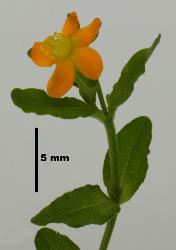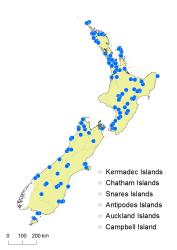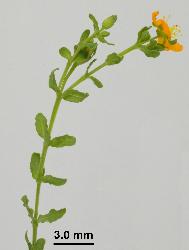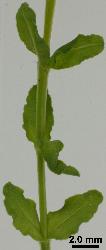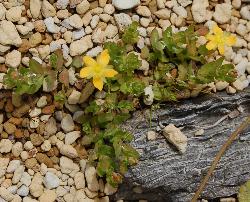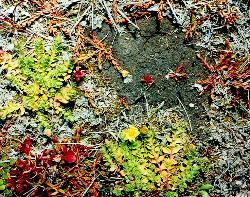- Taxon
- Gallery
- ≡ Ascyrum humifusum Labill., Nov. Holl. Pl. 2, 33, t. 175 (1806)
- ≡ Hypericum japonicum var. humifusum (Labill.) Hook.f., Bot. Antarct. Voy. III. (Fl. Tasman.) Part I, 53 (1855)
Subshrub, not rhizomatous, up to 50 mm high. Stems usually less than 100 mm, sometimes up to 200 mm, usually prostrate to decumbent, sometimes upright, 0.3–0.6 mm diam., quadrangular, 4-lined, black glands absent. Leaves 2.5–9.0 mm long, 1.5–3.5 mm wide, usually broadly elliptic or elliptic, glabrous, undulate, light green to yellow-green, abaxially sometimes slightly paler, reticulate tertiary veins absent; pellucid glands present; black glands absent; apex subacute to obtuse; margin strongly sinuate; base attenuate; sessile. Inflorescence terminal, in cymes, flowers usually solitary, sometimes up to 3, corolla 6.0–9.0 mm diam. Pedicels 3.7–3.8 mm long. Bracteoles absent. Sepals 5, 2.8–4.7 mm long, 0.9–1.4 mm wide, unequal widths, oblong, narrowly elliptic or elliptic-oblong; pellucid glands absent; black glands absent; apex subacute to rounded, sometimes with a small apiculus; margin entire. Petals 2.8–4.0 mm long, 1.7–2.5 mm wide, greater than sepals, obovate or oblong, pale yellow to dark yellow, black glands absent, persistent after anthesis. Stamens not in bundles, 9, c. 2.1 mm long, less than petals; anthers 0.2–0.3 mm long, anther gland absent. Ovary c. 1.3 mm long, 1.0–1.1 mm wide, ovoid, weakly trigonous in cross section. Styles usually 3, sometimes 4, 0.3–0.5 mm long, shorter than ovary. Fruit a capsule, 2.8–4.5 mm long, 2.2–3.8 mm wide, cylindric to globose, light brown. Seeds 0.5–0.75 mm long, c. 0.3 mm wide, oblong to elliptic oblong, terete, orange-brown to light yellow, longitudinal ribs absent, apices obtuse or rounded.
H. pusillum is distinguished by an absence of black glands, prostrate to decumbent main stems that originate from a central crown; rhizomatous stems are usually absent, quadrangular and 4-lined stems, leaves light green to yellow-green and with distinctly sinuate margins, and seeds elliptic-oblong and without ribs (see table of distinguishing characters under H. minutiflorum). Sometimes confused with H. humifusum, but that species has terete and 2-lined stems and conspicuous black glands on the leaves, sepals and often the petals.
North Island: Northland, Auckland, Volcanic Plateau, Taranaki, Gisborne, Southern North Island.
South Island: Western Nelson, Sounds Nelson, Marlborough, Canterbury, Westland, Otago, Southland.
Stewart Island.
Also Australia.
Occurs in a wide range of inland and coastal habitats, with a preference for wet or damp sites. For example, its grows on river and stream banks, lake and tarn margins, swamps and bogs, open areas in forest, and damp hollows among tussocks and grasses. It also grows in dry sites such as volcanic lava and tephra (Rangitoto Island) and on clay banks, and it can persist among pasture grasses and along tracks.
Also indigenous to Australia.
A putative hybrid between H. minutiflorum and H. pusillum has been collected from Ngamatea East Swamp, Rangitikei River, northern Wellington (CHR 85880). Another putative hybrid between H. involutum and H. pusillum has been collected from Takahue, Northland (CHR 295786).
Flowering: Sep.–Apr.
2n = 16 (de Lange et al. 2004, as H. japonicum).



